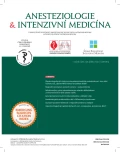Urgent infraglottic airway – cricothyroid puncture, cricothyrotomy and bougie-assisted cricothyrotomy (BACT)
Authors:
M. Otáhal 1; P. Michálek 1,2
Authors‘ workplace:
Klinika anesteziologie, resuscitace a intenzivní medicíny, 1. lékařská fakulta Univerzity Karlovy a Všeobecná fakultní nemocnice v Praze
1; Department of Anaesthesia, Antrim Area Hospital, Antrim, Spojené království
2
Published in:
Anest. intenziv. Med., 29, 2018, č. 3, s. 158-165
Category:
Review Article
Overview
Infraglottic needle/cannula insertion and surgical approaches to the trachea are the last resort choices of providing a patent airway, oxygenation and ventilation in patients where conventional techniques have failed. The main indication, especially in anaesthesia, is "can not intubate, can not oxygenate" situation. Infraglottic approaches may be the primary technique of providing patent airways in facial trauma, tumours, swelling, or in military medicine. Teaching and regular training on cadavers or models are key elements in managing these life-saving techniques, especially because their real frequency is extremely low. This review article discusses individual techniques – cricoid puncture, cricothyrotomy and bougie-assisted cricothyrotomy, their implementation, teaching, advantages and disadvantages.
Keywords:
infraglottic airway techniques – cricoid puncture – cricothyrotomy – bougie – teaching
Sources
1. Butler FK jr., Blackbourne LH. Battlefield trauma care then and now: a decade of Tactical Combat Casualty Care. J Trauma Acute Care Surg. 2012;73:S395−S402.
2. Cook TM, Woodall N, Frerk C. Major complications of airway management in the UK: results of the Fourth National Audit Project of the Royal College of Anaesthetists and the Difficult Airway Society. Part 1: anaesthesia. Br J Anaesth. 2011;106:617−631.
3. Bair AE, Panacek EA, Wisner DH, et al. Cricothyrotomy: a 5-year experience at one institution. J Emerg Med. 2003;24:151−156.
4. Hart KL, Thompson SH. Emergency cricothyrotomy. Atlas Oral Maxillofac Surg Clin North Am. 2010;18:29−38.
5. Henlin T, Michalek P, Tyll T, et al. A randomized comparison of bougie-assisted and TracheoQuick Plus cricothyrotomies on a live porcine model. BioMed Res Int. 2017;2017:4215159.
6. Votruba J, Zemanova P, Lambert L, et al. The role of airway and endobronchial ultrasound in perioperative medicine. BioMed Res Int. 2015;2015:754626.
7. Craven RM, Vanner RG. Ventilation of a model lung using various cricothyrotomy devices. Anaesthesia. 2004;59:595−599.
8. Langvad S, Hyldmo PK, Nakstad AR, et al. Emergency cricothyrotomy – a systematic review. Scand J Trauma Resusc Emerg Med. 2013;21:43.
9. Frerk C, Mitchell VS, McNarry AF, et al. Difficult Airway Society 2015 guidelines for management of unanticipated difficult intubation in adults. Br J Anaesth. 2015; 115:827–848.
10. Helmstaedter V, Wetsch WA, Böttiger BW, et al. Comparison of ready-to-use devices for emergency cricothyrotomy: randomized and controlled feasibility study on a mannequin. Anaesthetist. 2012;61:310−319.
11. MacIntyre A, Markarian MK, Carrison D, et al. Three-step emergency cricothyroidotomy. Mil Med. 2007;172:1228−1230.
12. Hill C, Reardon R, Joing S, et al. Cricothyrotomy technique using gum elastic bougie is faster than standard technique: a study of emergency medicine residents and medical students in an animal lab. Acad Emerg Med. 2010;17:666−669.
13. Černý V, Schreiberová J, Pavlínek O. Nácvik koniotomie na kadaverech – prospektivní studie. Anest Intenziv Med. 2003;14:214−217.
14. Makowski AL. The Ethics of Using the Recently Deceased to Instruct Residents in Cricothyrotomy. Ann Emerg Med. 2015;66:403−408.
15. Latif R, Chhabra N, Ziegler C, et al. Teaching the surgical airway using fresh cadavers and confirming placement non-surgically. J Clin Anesth. 2010;22:598−602.
16. Takayesu JK, Peak D, Stearns D. Cadaver-based training is superior to simulation training for cricothyrotomy and tube thoracostomy. Intern Emerg Med. 2017;12:99−102.
17. Hart D, McNeil MA, Hegarty C, et al. Literature evidence on live animal versus synthetic models for training and assessing trauma resuscitation procedures. J Spec Oper Med. 2016;16:44−51.
18. Luedi MM, Wolfl CC, Wieferich K, et al. Teaching Advanced Trauma Life Support (ATLS): a nationwide retrospective analysis of 8202 lessons taught in Germany. J Surg Educ. 2017;74:161−166.
19. www.das.uk.com/cricothyroidotomy_trainer_review
Labels
Anaesthesiology, Resuscitation and Inten Intensive Care MedicineArticle was published in
Anaesthesiology and Intensive Care Medicine

2018 Issue 3
Most read in this issue
- Urgent infraglottic airway – cricothyroid puncture, cricothyrotomy and bougie-assisted cricothyrotomy (BACT)
- Generalizovaný konvulzivní status epilepticus v dětském věku
- Regional anaesthesia for shoulder surgery – new trends
- Corticosteroids in regional anaesthesia and analgesia – state of the art
